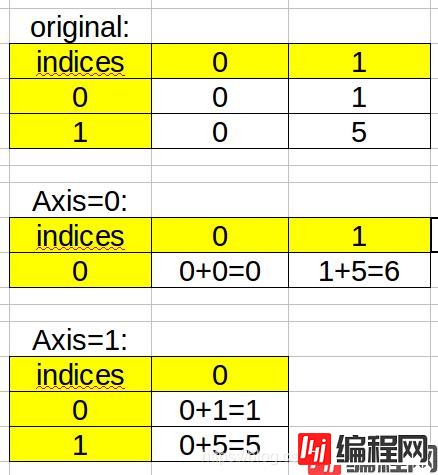Python 官方文档:入门教程 => 点击学习
numpy的sum函数可接受的参数是: sum(a, axis=None, dtype=None, out=None, keepdims=np._NoValue) 在参数列表中
numpy的sum函数可接受的参数是:
sum(a, axis=None, dtype=None, out=None, keepdims=np._NoValue)在参数列表中:
a是要进行加法运算的向量/数组/矩阵
axis的值可以为None,也可以为整数和元组
其形参的注释如下:
a : array_like elements to sum.
a:用于进行加法运算的数组形式的元素
axis : None or int or tuple of ints, optional
Axis or axes along which a sum is perfORMed.
The default, axis=None, will sum all of the elements of the input array.
If axis is negative it counts from the last to the first axis.
If axis is a tuple of ints, a sum is performed on all of the axes
specified in the tuple instead of a single axis or all the axes as before.
根据上文,可知:
axis的取值有三种情况:1.None,2.整数, 3.整数元组。
(在默认/缺省的情况下,axis取None)
如果axis取None,即将数组/矩阵中的元素全部加起来,得到一个和。
Example:
>>> np.sum([0.5, 1.5])
2.0
>>> np.sum([0.5, 0.7, 0.2, 1.5], dtype=np.int32)
1
>>> np.sum([[0, 1], [0, 5]])
6
如果axis为整数,axis的取值不可大于数组/矩阵的维度,且axis的不同取值会产生不同的结果。
先以2×2的二维矩阵为例:
>>> np.sum([[0, 1], [0, 5]], axis=0)
array([0, 6])
>>> np.sum([[0, 1], [0, 5]], axis=1)
array([1, 5])在上述例子中
具体理解如图:

如果axis为整数元组(x,y),则是求出axis=x和axis=y情况下得到的和。
继续以上面的2×2矩阵为例
>>>np.sum([[0,1],[0,5]],axis=(0,1))
>>>6
>>>np.sum([[0,1],[0,5]],axis=(1,0))
>>>6另外,需要注意的是:如果要输入两个数组/矩阵/向量进行相加,那么就要先把两个数组/矩阵/向量用一个括号括起来,形成一个元组,这样才能够进行相加。因为numpy.sum的运算实现本质是通过矩阵内部的运算实现的。
当然,如果只是向量/数组之间做加法运算,可以直接让两个向量/数组相加,但前提是它们必须为numpy的array数组才可以,否则只是单纯的列表相加
Example:
>>>v1 = [1, 2]
>>>v2 = [3, 4]
>>>v1 + v2
[1, 2, 3, 4]
>>>v1 = numpy.array[1, 2]
>>>v2 = numpy.array[3, 4]
>>>v1 + v2
[4, 6]
到此这篇关于numpy.sum()的使用详解的文章就介绍到这了,更多相关numpy.sum()使用内容请搜索编程网以前的文章或继续浏览下面的相关文章希望大家以后多多支持编程网!
--结束END--
本文标题: numpy.sum()的使用详解
本文链接: https://lsjlt.com/news/121469.html(转载时请注明来源链接)
有问题或投稿请发送至: 邮箱/279061341@qq.com QQ/279061341
2024-03-01
2024-03-01
2024-03-01
2024-02-29
2024-02-29
2024-02-29
2024-02-29
2024-02-29
2024-02-29
2024-02-29
回答
回答
回答
回答
回答
回答
回答
回答
回答
回答
0